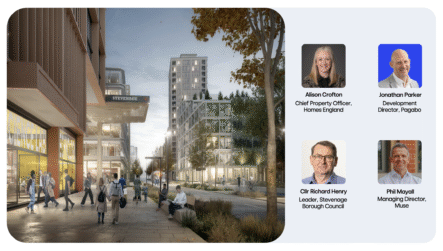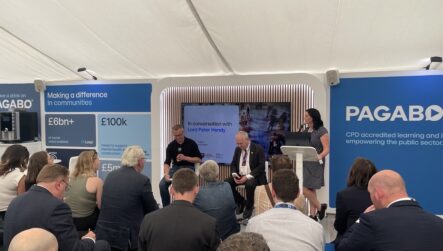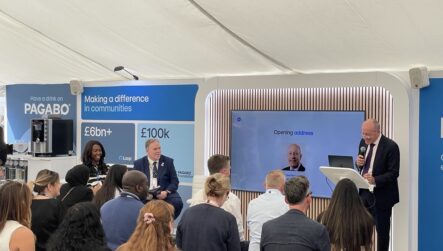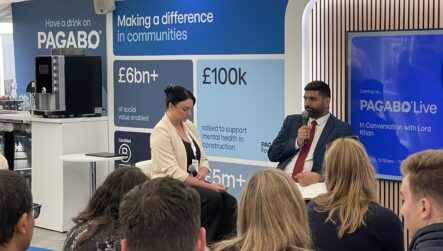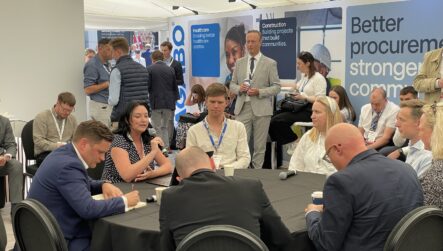
As procurement reform kicks in with the go-live of the Procurement Act, industry conversation is steering towards the reality of the changes it brings. Furthermore, a prominent question is, what does the implementation mean for one of the built environments biggest talking points – social value?
In the latest Pagabo Live, a collection of experts shared their thoughts on social value in relation to the new act, and what can be seen as a new age for social impact and community collaboration.
Spearheaded by our regular host Tom Snee of Cartwright Communications, the session showcased a panel of experts from across the sector including Will Campbell, social value engagement lead at Loop, Natalie Webster, senior social sustainability manager at Tier one contractor Kier, Duncan McNicol, head of risk and compliance at City Building Engineering Services (CBES), Sarah O’Mahoney, social value manager and Paul McCulloch, head of supply chain and strategic projects, both representatives from Octavius.
Looking at the bigger picture
Kicking off the session, our first poll gauged the audience’s current understanding of social value under the Procurement Act, with 52% of attendees confirming they still had considerable room for the growth of their knowledge.
To understand social value in relation to the Procurement Act, we must first understand why it is such a critical consideration in public sector procurement. On this, Natalie suggested that more efforts these days are more specific on tackling societal issues that can surround a project on a localised community level – and a focus on this can act as a differentiator between suppliers, when in the initial tender process for winning work.
From Will’s perspective, social value is challenging procurers to think beyond project price tags and look at the bigger picture. It’s this transition of social value outputs and the effect on the procurement process that is making it such a critical consideration.
As an industry, the conversation could continue for years to come regarding how success can be adequately defined when it comes to social value, with common courtesy given to the conversation that a ‘not one size fits all’ approach is best suited.
With the issue of social value becoming more prominent in relation to procurement, Sarah suggested that to be effective, social value delivery has to have a bigger picture approach. Understanding local needs, engaging teams and staying accountable are all efforts that need to be embedded at the very start of the procurement process – it cannot be effective as an afterthought. Whether short- or long-term goals, each project and its needs or goals must be looked at individually to help define ‘what good looks like’ for each of them.
The issue of social value reporting is difficult, but this is not necessarily a bad issue for us to have. As an industry, we’re trying to quantify social value elements that can’t be compartmentalised, yet the impact of them is standout. Social value is not just numbers and is more than just KPIs. It is real life impact, and championing of resources, wellbeing and support where it is needed most. That’s why quality digital solutions are so vital.
Social value in the Procurement Act age
As the go-live date approaches, our panellists were asked for their thoughts on how the Procurement Act gives importance to social value, with Will suggesting that it champions social value, clearly showcasing it as fundamental to procurement decisions.
From Paul’s perspective, the upcoming changes open the door to encouraging the public purse to be spent for good. These ‘good’ results should take precedence over the issue of cost as standard practice, moving towards seeing best value as an all-encompassing measure specific to projects and communities – something it was very pleasing to hear that all panellists are seeing more of.
The suggestion here is that in the past, legislation hasn’t been exactly clear. However, now the Procurement Act is supporting the opportunity and space for effective social value delivery in which defining legacy and ongoing community support can be characterising project factors.
The shift has been strengthened and reflected by the change of focus from MEAT (Most Economically Advantageous Tender) to MAT (Most Advantageous Tender).
We are seeing change in how procurement decisions are being made, with project economics no longer the deciding factor in the process. Instead, the industry is increasingly looking beyond cost, and instead at a holistic approach. This gives greater flexibility, supports wider benefits and encourages the inclusion of SMEs into the sector through procurement, breaking down historic barriers.
The MEAT focus is a product of its own upbringing within the industry, with public sector procurement being largely defined by the monetary pressures felt by local authorities, placing cost as the most important consideration. Duncan placed collaboration as a clear indicator here, with support for local authorities being increasingly crucial, to support them in seeing the huge community impact available when thinking of the bigger picture.
The development of technology and its adoption within the built environment has set the sector as a whole on a newfound path of longevity, with the benefits effective technology can have is truly impactful.
The benefits of best practice
From Sarah’s perspective, digital solutions champion accuracy in social value measurement, and along with the option for real-time data tracking can reduce any surprises cropping up when it comes to reporting through human error and data inconsistencies.
As highlighted by Will, an increase in efficiency is also a top indicator to the success of tools like Loop, creating significant admin and time savings to help users. For example, when data collection across teams may have proven traditionally tricky, solutions like Loop reduce this, allowing for greater, and easier, collaboration.
In terms of implementation of digital tools, our second poll question showed that most viewers are open to exploring them, with many already having a solution implemented.
A core advantage of effective social value is the real-life tangible examples of its success, which our panellists were happy to share with the audience. Sarah shared details of the Chelmsford Northeast Bypass project which was procured through the Civil Engineering & Infrastructure Framework that we manage for contracting authority, QE Facilities. This scheme, contributed £4 million to the local community through collaboration with the local supply chain, hiring of seven local people, and focuses on environmental impact, community support, volunteer work and providing further training opportunities.
From a more general perspective, Natalie sees pre-set social value targets as optimal for procured project success, echoing our previous point that for social value efforts to be successful, embedding at those early stages is vital.
A final note
At the point of asking our closing poll question, results showed that 83% viewers sat in the increased understanding sideof social value in line with the Procurement Act.
Top advice from our panellists focused in further on that early social value implementation for projects, along with the importance of early engagement with suppliers to set defining goals in terms of social value delivery.
It is also important to be brave about upcoming adjustments, and to not succumb to the pressure to focus on the pounds and pence so much we lose sight of the bigger picture.
Claim your CPD credit
Don’t forget that Pagabo Live now has a CPD accreditation for its knowledge offering. If you are tuned in live to our sessions, you will receive a link via email afterwards to claim your CPD credit.
Our next Pagabo Live session will be on Wednesday 19 March, when we’ll be taking an even deeper dive into the Procurement Act – focusing on how to progress once the changes are finally live. Click here to register: https://pagabo.co.uk/episodes/webinar-procurement-reform-is-live-what-now/
Discover our frameworks

